Themed collection Chemical compartmentalisation by membranes: from biological mechanism to biomimetic applications

Chemical compartmentalisation by membranes: from biological mechanism to biomimetic applications
This issue presents a themed collection on investigating, harnessing and mimicking biological compartmentalisation using in vitro model systems, where biophysical mechanisms and biomembrane engineering are essential for realisation of the potential of membrane-bound compartments.
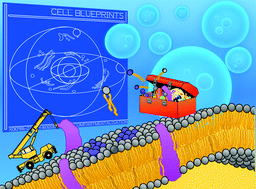
Phys. Chem. Chem. Phys., 2015,17, 15487-15488
https://doi.org/10.1039/C5CP90089A
Bioinspired nanoreactors for the biomineralisation of metallic-based nanoparticles for nanomedicine
A review of biological nanoreactor to make nanomedical metallic-based nanoparticles: from natural biomineralisation to biokleptic templating to synthetic vesicles.

Phys. Chem. Chem. Phys., 2015,17, 15508-15521
https://doi.org/10.1039/C5CP00375J
Membrane adhesion and the formation of heterogeneities: biology, biophysics, and biotechnology
How membrane adhesion links to lipid and protein heterogeneities is not well-understood and is an understudied area ripe for development.
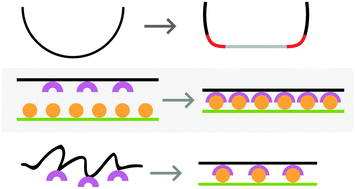
Phys. Chem. Chem. Phys., 2015,17, 15522-15533
https://doi.org/10.1039/C4CP05876C
Nature's lessons in design: nanomachines to scaffold, remodel and shape membrane compartments
Our understanding of the membrane sculpting capabilities of proteins from experimental model systems could be used to construct functional compartmentalised architectures for the engineering of synthetic cells.
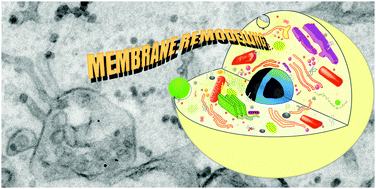
Phys. Chem. Chem. Phys., 2015,17, 15489-15507
https://doi.org/10.1039/C5CP00480B
Protein synthesis in artificial cells: using compartmentalisation for spatial organisation in vesicle bioreactors
Spatially segregated in vitro protein expression in a vesicle-based artificial cell, with different proteins synthesised in defined vesicle regions.

Phys. Chem. Chem. Phys., 2015,17, 15534-15537
https://doi.org/10.1039/C4CP05933F
Mechanical and molecular basis for the symmetrical division of the fission yeast nuclear envelope
Experimental and theoretical evidence shows that symmetrical shapes of the fission yeast dividing nucleus originate from the SPB–chromosome attachments.
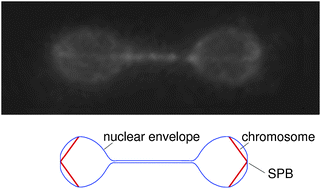
Phys. Chem. Chem. Phys., 2015,17, 15629-15636
https://doi.org/10.1039/C5CP01243K
Direct measurement of DNA-mediated adhesion between lipid bilayers
Multivalent interactions between deformable mesoscopic units are ubiquitous in biology, where membrane macromolecules mediate the interactions between neighbouring living cells and between cells and solid substrates.
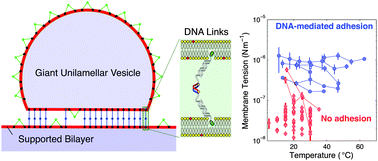
Phys. Chem. Chem. Phys., 2015,17, 15615-15628
https://doi.org/10.1039/C5CP01340B
Supramolecular amphipathicity for probing antimicrobial propensity of host defence peptides
Supramolecular amphipathicity exposes antimicrobial propensity of host defence peptides.
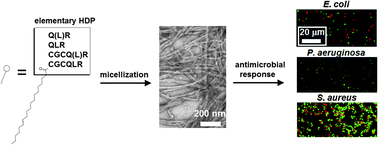
Phys. Chem. Chem. Phys., 2015,17, 15608-15614
https://doi.org/10.1039/C5CP01185J
Specific adhesion of membranes simultaneously supports dual heterogeneities in lipids and proteins
Membrane adhesion mediated by one protein species simultaneously stabilizes both ordered-phase and disordered-phase heterogeneities, distinct from the non-adhered membrane.
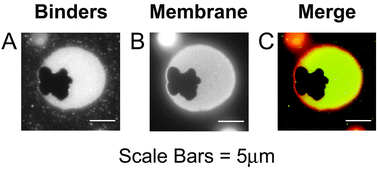
Phys. Chem. Chem. Phys., 2015,17, 15598-15607
https://doi.org/10.1039/C4CP05877A
Methyl-branched lipids promote the membrane adsorption of α-synuclein by enhancing shallow lipid-packing defects
Reconstitution experiments on Giant Unilamellar Vesicles and Molecular Dynamics Simulations indicate that alpha-synuclein binds to neutral flat membranes in the presence of methyl-branched lipids.
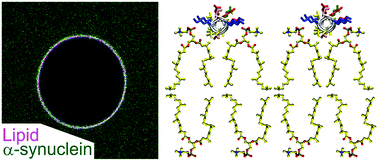
Phys. Chem. Chem. Phys., 2015,17, 15589-15597
https://doi.org/10.1039/C5CP00244C
Release of proteins and enzymes from vesicular compartments by alternating magnetic fields
The self-assembly of avidin, biotinylated vesicles and biotinylated (3-aminopropyl)triethoxysilane-coated magnetite nanoparticles gave a nanomaterial able to magnetically release catalytically active enzymes from vesicular compartments.
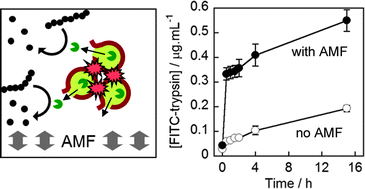
Phys. Chem. Chem. Phys., 2015,17, 15579-15588
https://doi.org/10.1039/C4CP05872K
Selective ion-permeable membranes by insertion of biopores into polymersomes
Biomimetic polymersomes with an ion-selective membrane were successfully engineered by insertion of ionomycin, without affecting their final architecture.
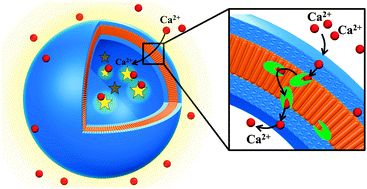
Phys. Chem. Chem. Phys., 2015,17, 15538-15546
https://doi.org/10.1039/C4CP05879H
Inside-outside self-assembly of light-activated fast-release liposomes
Schematic and TEM image of thermosensitive liposomes with NIR-absorbing nanoparticles.
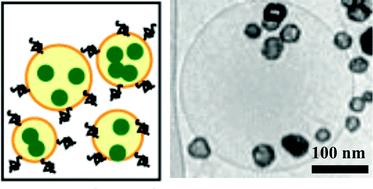
Phys. Chem. Chem. Phys., 2015,17, 15569-15578
https://doi.org/10.1039/C4CP05881J
Biophysics of α-synuclein induced membrane remodelling
α-Synuclein leads to thinning, and subsequent tubulation of membrane bilayer.
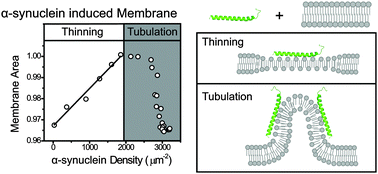
Phys. Chem. Chem. Phys., 2015,17, 15561-15568
https://doi.org/10.1039/C4CP05883F
Native silica nanoparticles are powerful membrane disruptors
Silica nanoparticles permeabilize liposomal membranes as a function of nanoparticle size, surface chemistry and biocoating as well as membrane charge.
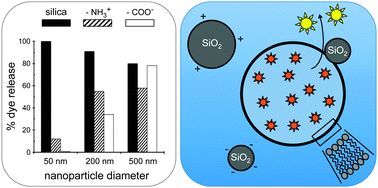
Phys. Chem. Chem. Phys., 2015,17, 15547-15560
https://doi.org/10.1039/C4CP05882H
About this collection
Biology maintains its complex network of biochemical interactions and reactions by spatially localising these processes into distinct compartments. These compartments are usually confined by highly dynamic and functional membranes, which regulate material transport processes within the cell. Physical scientists have developed methods to reconstitute in vitro models of these functional interfaces and compartments, whether they may be membranes composed of natural lipids, or biomimetic self-assembled membranes constructed from block copolymers or polyelectrolytes. This themed issue is devoted to research into understanding, mimicking and harnessing the compartmentalisation of biology using in vitro model systems.
The Guest Editors for this themed collection are Barbara Ciani (University of Sheffield, UK) and Paul Beales (University of Leeds, UK).